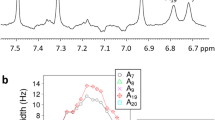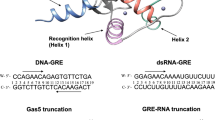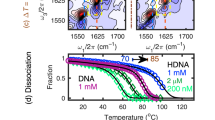Abstract
The solution structure of a complex between a truncated form of HMG-I(Y), consisting of the second and third DNA binding domains (residues 51–90), and a DNA dodecamer containing the PRDII site of the interferon-β promoter has been solved by multidimensional nuclear magnetic resonance spectroscopy. The stoichiometry of the complex is one molecule of HMG-I(Y) to two molecules of DNA. The structure reveals a new architectural minor groove binding motif which stabilizes B-DNA, thereby facilitating the binding of other transcription factors in the opposing major groove. The interactions involve a central Arg-Gly-Arg motif together with two other modules that participate in extensive hydrophobic and polar contacts. The absence of one of these modules in the third DNA binding domain accounts for its ∼100 fold reduced affinity relative to the second one.
This is a preview of subscription content, access via your institution
Access options
Subscribe to this journal
Receive 12 print issues and online access
$209.00 per year
only $17.42 per issue
Buy this article
- Purchase on SpringerLink
- Instant access to full article PDF
Prices may be subject to local taxes which are calculated during checkout
Similar content being viewed by others
References
Bustin, M. & Reeves, R. High-mobility-group chromosomal proteins: architectural components that facilitate chromatin function. Progr. Nucl. Acids Res. 54, 35–100 (1996).
Thanos, D. & Maniatis, T. The high mobility group protein HMG I(Y) is required for NF-κB-dependent virus induction of the human IFN-β gene. Cell 71, 777–789 (1992).
Du, W., Thanos, D. & Maniatis, T. Mechanisms of transcriptional synergism between distinct virus-inducible enhancer elements. Cell 74, 887–898 (1993).
Falvo, J.V., Thanos, D. & Maniatis, T. Reversal of intrinsic DNA bends in the IFN-β gene enhancer by transcription factors and the architectural protein HMGI(Y). Cell 83, 1101–1111 (1995).
Farnet, C.M. & Bushman, F.D. HIV-1 cDNA integration: requirement of HMG I(Y) protein for function of preintegration complexes in vitro. Cell 88, 483–492 (1997).
Zeleznik-Le, N.J., Harden, A.M. & Rowley, J.D. 11q23 translations split the ‘AT-hook’ cruciform DMA-binding region and the transcriptional repression domain from the activation domain of the mixed-lineage leukemia (MLL) gene. Proc. Natl. Acad. Sci. U.S.A. 91, 10610–10614 (1994).
Zhou, X., Benson, K.F., Ashar, H.R. & Chada, K. Mutation responsible for the mouse pygmy phenotype in the developmentally regulated factor HMGI-C. Nature 376, 771–774 (1995).
Ashar, H.R. et al. Disruption of the architectural factor HMGI-C: DNA-binding AT hook motifs fused in lipomas of distinct transcriptional regulatory domains. Cell 82, 57–65 (1995).
Schoenmakers, E.F.P.M., Wanschura, S., Mols, R., Bullerdiek, J., Van den Berghe, H. & Van de Ven, W.J.M. Recurrent rearrangements in the high mobility group protein gene, HMGI-C, in benign mesenchymal tumours. Nature Genet. 10, 436–444 (1995).
Reeves, R. & Nissen, M.S. The A·T-DNA-binding domain of mammalian high mobility group I chromosomal proteins. J. Biol. Chem. 265, 8573–8582 (1990).
Claus, P., Schulze, E. & Wisniewski, J.R. Insect proteins homologous to mammalian high mobility group proteins I/Y (HMG I/Y). J. Biol. Chem. 269, 33042–33048 (1994).
Tjandra, N., Wingfield, P., Stahl, S. & Bax, A. Anisotropic rotational diffusion of perdeuterated HIV protease from 15N NMR relaxation measurements at two magnetic fields. J. Biomol. NMR 8, 273–284 (1996).
Clore, G.M. & Gronenborn, A.M. Structures of larger proteins in solution: three- and four-dimensional heteronuclear NMR spectroscopy. Science 252, 1390–1399 (1991).
Bax, A. & Grzesiek, S. Methodological advances in protein NMR Acct. Chem. Res. 26, 131–138 (1993).
Gronenborn, A.M. & Clore, G.M. Structures of protein complexes by multidimensional heteronuclear magnetic resonance spectroscopy. CRC Crit Rev. Biochem. Mol. Biol. 30, 351–385 (1995).
Bax, A. et al. Measurement of homo- and hetero-nuclear J couplings from quantitative J correlation. Meth. Enz. 239, 79–106 (1994).
Geierstanger, B.H., Volkman, B.F., Kremer, W. & Wemmer, D.E. Short peptide fragments derived from HMG-I(Y) proteins bind specifically to the minor groove of DNA. Biochemistry 33, 5347–5355 (1994).
Solomon, M.J., Strauss, F. & Varshavsky, A. A mammalian high mobility group protein recognizes any stretch of six A·T base pairs in duplex DNA. Proc. Natl. Acad. Sci. U.S.A. 83, 1276–1280 (1986).
Kim, Y., Geiger, J.H., Hahn, S. & Sigler, P.B. Crystal structure of a yeast TBP/TATA-box complex. Nature 365, 512–520 (1993).
Kim, J.L., Nikolov, D.B. & Burley, S.K. Co-crystal structure of TBP recognizing the minor groove of a TATA element. Nature 365, 520–527 (1993).
Werner, M.H., Huth, J.R., Gronenborn, A.M. & Clore, G.M. Molecular basis of human 46X,Y sex reversal revealed from the three-dimensional solution structure of the human SRY-DNA complex. Cell 81, 705–714 (1995).
Love, J.J. et al. Structural basis for DNA bending by the architectural transcription factor LEF-1. Nature 376, 791–795 (1995).
Rice, P.A., Yang, S.-W., Mizuuchi, K. & Nash, H.A. Crystal structure of an IHF-DNA complex: a protein-induced DNA U-turn. Cell 87, 1295–1306 (1996).
Pearson, W.R. & Lipman, D.J. Improved tools for biological sequence comparison. Proc. Natl. Acad. Sci. U.S.A. 85, 2444–2448 (1988).
Levinger, L. & Varshavsky, A. Protein D1 preferentially binds A+T-rich DNA in vitro and is a component of Drosophila melanogaster nucleosomes containing A+T-rich satellite DNA. Proc. Natl. Acad. Sci. U.S.A. 79, 7152–7156 (1982).
Meluh, P.B. & Koshland, D. Evidence that the MIF2 gene of Saccharomyces cerevisiae encodes a centromere protein with homology to the mammalian centromere. Mol. Biol. Cell. 6, 793–807 (1997).
Prasad, R. et al. Leucine-zipper dimerization motif encoded by the AF17 gene fused to ALL-1 (MLL) in acute leukemias. Proc. Natl. Acad. Sci. U.S.A. 91, 8107–8111 (1994).
Maher, J.F. & Nathans, D. Multivalent DNA-binding properties of the HMG-I proteins. Proc. Natl. Acad. Sci. U.S.A. 93, 6716–6720 (1996).
Goodsell, D.S., Kopka, M.L. & Dickerson, R.E. Refinement of netropsin bound to DNA: bias and feedback in electron density map interpretation. Biochemistry 34, 4983–4993 (1995).
Mrksich, M., Parks, M.E. & Dervan, P.B. A new class of oligopeptides for sequence-specific recognition in the minor groove of double helical DNA. J. Am. Chem. Soc. 116, 7983–7988 (1994).
Gronenborn, A.M. et al. A novel, highly stable fold of the immunoglobulin binding domain of Streptococcal protein G. Science 253, 657–661 (1991).
Hu, J.-S. & Bax, A. Measurement of three-bond 13C-13C J couplings between carbonyl and carbonyl/carboxyl carbons in isotopically enriched proteins. J. Am. Chem. Soc. 118, 8170–8171 (1996).
Hu, J.-S. & Bax, A. Determination of Φ and χ1 angles in proteins from 13C-13C three-bond J couplings measured by three-dimensional heteronuclear NMR. How planar is the peptide bond. J. Am. Chem. Soc., in press (1997).
Delaglio, F. et al. NMRPipe: a multidimensional spectral processing system based on UNIX pipes. J. Biomolec. NMR 6, 277–293 (1995).
Garrett, D.S., Powers, R., Gronenborn, A.M. & Clore, G.M. A common sense approach to peak picking in two-, three- and four-dimensional spectra using automatic computer analysis of contour diagrams. J. Magn. Reson. 95, 214–220 (1991).
Omichinski, J.G., Pedone, P.V., Felsenfeld, G., Gronenborn, A.M. & Clore, G.M. The solution structure of a specific GAGA factor-DNA complex reveals a modular binding mode. Nature Struct. Biol. 4, 122–132 (1997).
Nilges, M., Clore, G.M. & Gronenborn, A.M. Determination of three-dimensional structures of proteins from interproton distance data by hybrid distance geometry-dynamical simulated annealing calculations. FEBS Lett. 229, 317–324 (1988).
Brünger, A.T. X-PLOR Version 3.1: A system for X-ray crystallography and NMR. (Yale University Press, New Haven, Connecticut; 1993).
Garrett, D.S. et al. The impact of direct refinement against three-bond HN-CαH coupling constants on protein structure determination by NMR. J. Magn. Reson. Series B 104, 99–103 (1994).
Kuszewski, J., Qin, J., Gronenborn, A.M. & Clore, G.M. The impact of direct refinement against 13Cα and 13Cβ chemical shifts on protein structure determination by NMR. J. Magn. Reson. Series B 106, 92–96 (1995).
Kuszewski, J., Gronenborn, A.M. & Clore, G.M. Improving the quality of NMR and crystallographic protein structures by means of a conformational database potential derived from structure databases. Prot Sci. 5, 1067–1080 (1996).
Kuszewski, J., Gronenborn, A.M. & Clore, G.M. Improvements and extensions in the conformational database potential for the refinement of NMR and X-ray structures of proteins and nucleic acids. J. Magn. Reson. 125, 171–177 (1997).
Lavery, R. & Skelnar, H. Defining the structure of irregular nucleic acids: conventions and principles. J. Biomol. Struct. Dyn. 6, 655–667 (1989).
Nilges, M. A calculational strategy for the structure determination of symmetric dimers by 1H NMR. Prot. Struct. Funct. Genet. 17, 297–309 (1993).
Nicholls, A., Sharp, K.A. & Honig, B. Protein folding and association: insights from the interfacial and thermodynamic properties of hydrocarbons. Prot. Struct. Funct. Genet. 11, 281–296 (1991).
Brooks, B.R. CHARMM: a program for macromolecular energy minimization and dynamics calculations. J. Comput. Chem. 4, 187–217 (1993).
Author information
Authors and Affiliations
Rights and permissions
About this article
Cite this article
Huth, J., Bewley, C., Nissen, M. et al. The solution structure of an HMG-I(Y)–DNA complex defines a new architectural minor groove binding motif. Nat Struct Mol Biol 4, 657–665 (1997). https://doi.org/10.1038/nsb0897-657
Received:
Accepted:
Issue Date:
DOI: https://doi.org/10.1038/nsb0897-657



